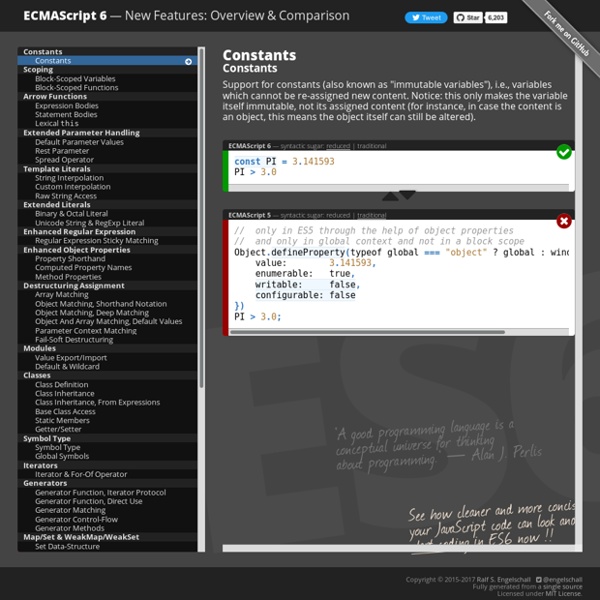



http://es6-features.org/#Constants
Related: ES6/ES2015 • ES6+ (ECMAScript 2015+) • JavaScriptJavaScript Promises: There and back again Ladies and gentlemen, prepare yourself for a pivotal moment in the history of web development… [Drumroll begins] Promises have arrived natively in JavaScript! New ES2018 Features Every JavaScript Developer Should Know Learn Development at Frontend Masters The ninth edition of the ECMAScript standard, officially known as ECMAScript 2018 (or ES2018 for short), was released in June 2018. Starting with ES2016, new versions of ECMAScript specifications are released yearly rather than every several years and add fewer features than major editions used to. The newest edition of the standard continues the yearly release cycle by adding four new RegExp features, rest/spread properties, asynchronous iteration, and Promise.prototype.finally. Additionally, ES2018 drops the syntax restriction of escape sequences from tagged templates. These new changes are explained in the subsections that follow.
Deploying ECMAScript 6 This blog post describes the options you have for deploying ECMAScript 6 in current JavaScript environments. It is selective w.r.t. the amount of tools it covers. If you want a comprehensive list of tools, I suggest you look at Addy Osmani’s “ECMAScript 6 Tools”. ES6 Overview in 350 Bullet Points Apologies about that long table of contents, and here we go. ES6 – also known as Harmony, es-next, ES2015 – is the latest finalized specification of the language The ES6 specification was finalized in June 2015, (hence ES2015) Future versions of the specification will follow the ES[YYYY] pattern, e.g ES2016 for ES7 Yearly release schedule, features that don’t make the cut take the next train Since ES6 pre-dates that decision, most of us still call it ES6 Starting with ES2016 (ES7), we should start using the ES[YYYY] pattern to refer to newer versions Top reason for naming scheme is to pressure browser vendors into quickly implementing newest features (back to table of contents) A new primitive type in ES6 You can create your own symbols using var symbol = Symbol() You can add a description for debugging purposes, like Symbol() Symbols are immutable and unique. Time for a bullet point detox. Then again, I did warn you to read the article series instead.
Hilbert's Grand JavaScript School (2015 Edition) (This material originally appeared, using ECMAScript-5 semantics, in 2013.) Dr. Hilbert “Bertie” David grows tired of blogging about JavaScript, and decides to cash in on the seemingly inexhaustible supply of impressionable young minds seeking to “Learn JavaScript in Five Days.” He opens his Grand JavaScript School on the shores of the Andaman Sea in Thailand, and with some clever engineering, he is able to install a countably infinite number of seats in his lecture hall. day one
JavaScript modules JavaScript modules are now supported in all major browsers! Chrome: supported since version 61Firefox: supported since version 60Safari: supported since version 11Node.js: supported since version 13.2.0Babel: supported This article explains how to use JS modules, how to deploy them responsibly, and how the Chrome team is working to make modules even better in the future. What are JS modules? # De Stijl: How necessary are var, let, and const? Disclaimer: JavaScript the language has some complicated edge cases, and as such, the following essay has some hand-wavey bits and some bits that are usually correct but wrong for certain edge cases. If it helps any, pretend that nearly every statement has a footnote reading, “for most cases in practice, however ______.” ECMAScript-2015 gives us three different variable declaration statements: var, let, and const.
The Complete Guide to ES10 Features - JavaScript Teacher - Medium ES10 is no longer just a draft! All features have already been implemented in major browsers. Here is a non-alien guide for anyone interested in exploring ES10, released June 2019. Follow me on Twitter for JavaScript tips and book announcements. ES6 In Depth – Symbols ES6 In Depth is a series on new features being added to the JavaScript programming language in the 6th Edition of the ECMAScript standard, ES6 for short. Note: There is now a Vietnamese translation of this post, created by Julia Duong of the Coupofy team. What are ES6 symbols? Symbols are not logos. They’re not little pictures you can use in your code.
An intro to the spread operator and rest parameter in JavaScript (ES6) Both the spread operator and the rest parameter are written as three consecutive dots (…). Do they have anything else in common? The spread operator was introduced in ES6. It provides you with the ability to expand iterable objects into multiple elements. What does it really mean? Let’s check some examples. Private Members in JavaScript Douglas Crockford www.crockford.com JavaScript is the world's most misunderstood programming language. Some believe that it lacks the property of information hiding because objects cannot have private instance variables and methods. But this is a misunderstanding.
Metaprogramming in ES6: Symbols and why they're awesome You've heard of ES6 right? It's the new version of JavaScript that is awesome in so many ways. I frequently wax lyrical about all of the amazing new features I keep discovering with ES6, much to the chagrin of my colleagues (consuming someone's lunch break talking about ES6 Modules seems to be not to everyone's liking). A set of great new features for ES6 comes in the form of a slew of new metaprogramming tools, which provide low level hooks into code mechanics. Not much has been written on them, so I thought I'd do a teensy weensy 3 part post on them (sidebar; because I'm so lazy and this post has been sat in my drafts folder - 90% done - for three months, a bit more has been written about them since I said that):